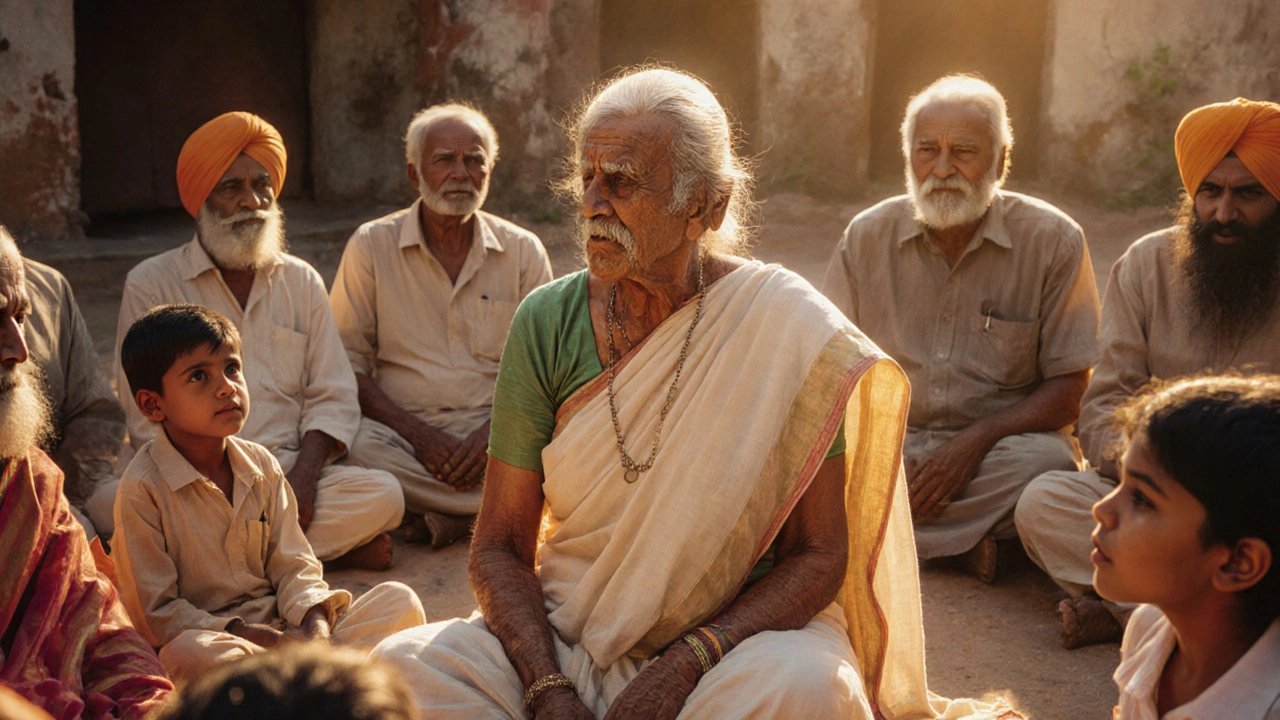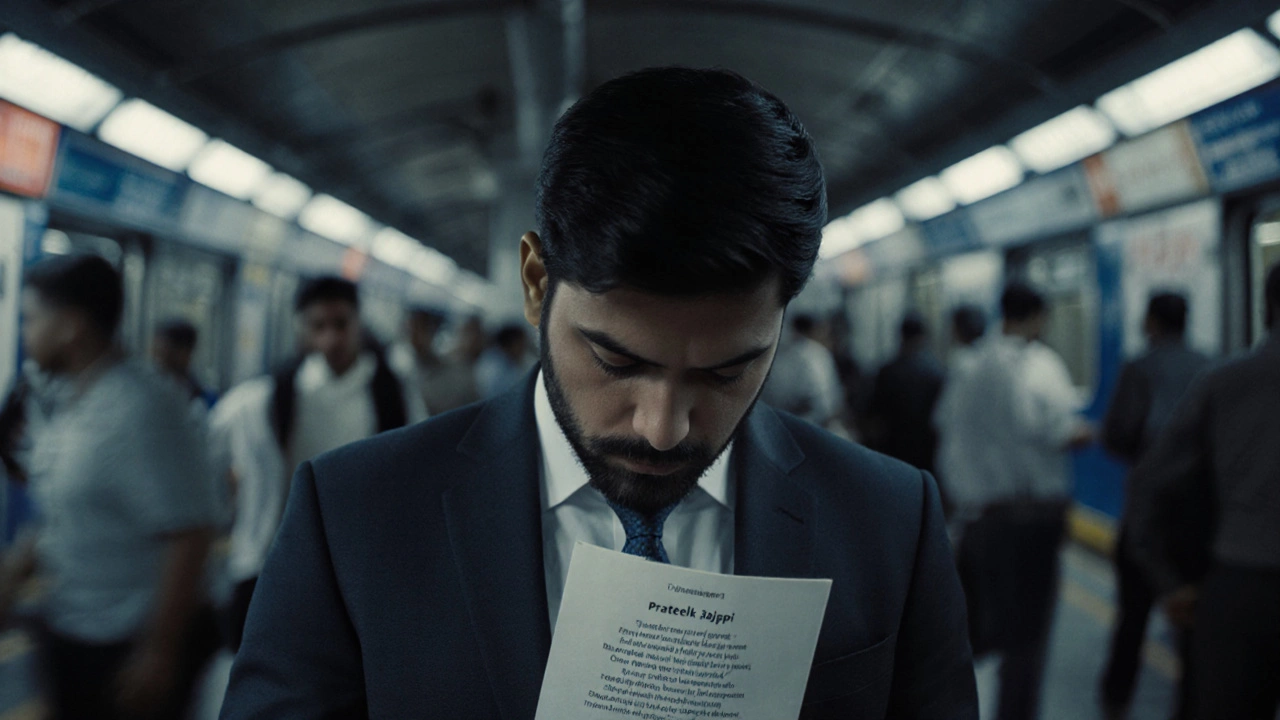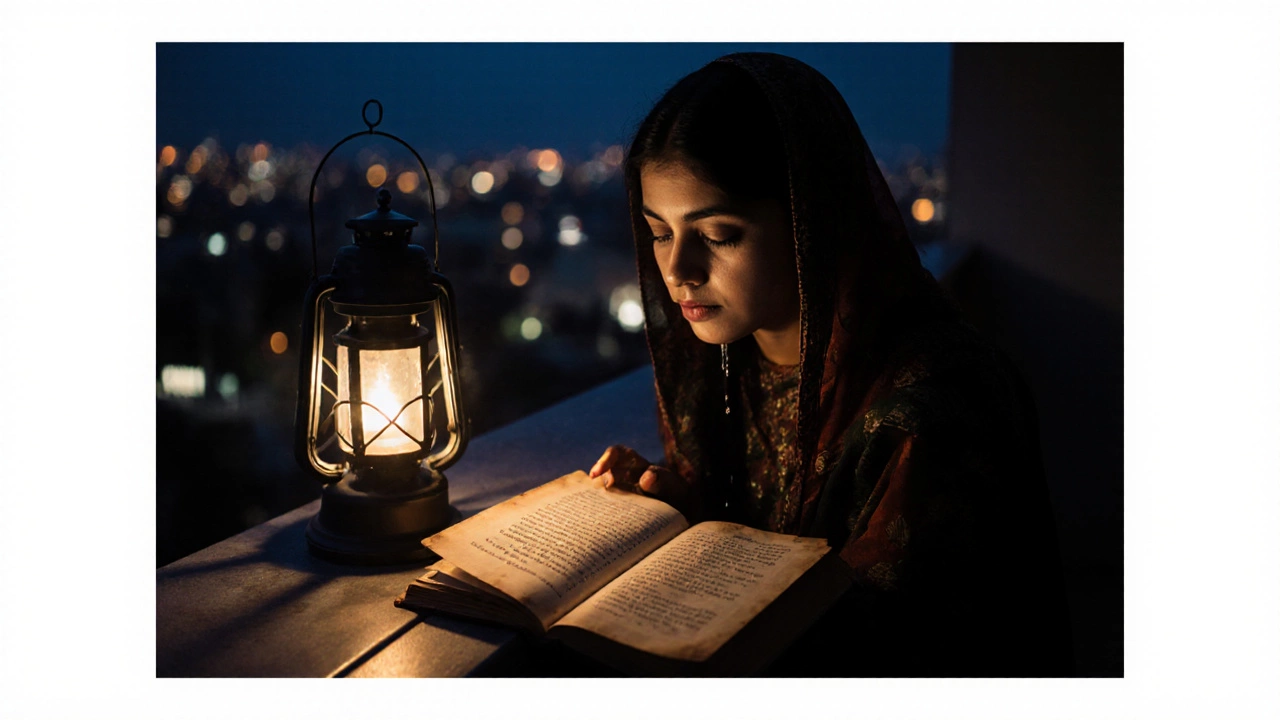Emotional Suppression Checker
How much are you holding back?
Answer 5 questions about your emotional patterns. This tool uses insights from Indian cultural context and scientific research to help you understand emotional suppression.
Your Emotional Suppression Score
There’s a quiet tension in many Indian homes when someone starts to cry. A mother whispers, "Rona mat, beta," a father turns away, a grandmother sighs and says, "Log kya kahenge?" - What will people say? For generations, tears have been treated like secrets - something to swallow, to hide, to outgrow. But what if holding it in is costing you more than letting it out?
In India, sadness has always had a voice - not in loud protests, but in poetry. From Mir Taqi Mir’s Urdu couplets to Kabir’s dohas, from Rabindranath Tagore’s Bengali verses to contemporary poets like Arundhathi Subramaniam, Indian sad poetry doesn’t ask you to be strong. It asks you to be real. It says: "Tears are not weakness. They are the language of the soul when words fail."
Think about it. When was the last time you saw someone cry in public in India and not feel awkward? We’re taught to smile through pain. To nod when asked, "Sab theek hai?" - Are you okay? - even when your chest feels like it’s cracking. But here’s the truth: holding back tears doesn’t make you stronger. It just makes you heavier.
What Happens When You Hold Back Tears
Your body doesn’t lie. When you suppress emotion, it doesn’t vanish. It moves. It settles. Studies show that chronic emotional suppression increases cortisol levels - the stress hormone - which can lead to higher blood pressure, weakened immunity, and even digestive issues. In India, where stress from family expectations, work pressure, and social judgment is already high, holding back tears becomes a silent burden.
Imagine a young woman in Delhi who lost her father. She cried once, in private, after the funeral. Her aunt told her, "Ab tum badi ho gayi ho. Aise nahi karte." - You’re grown up now. You don’t do that. So she stopped. Five years later, she started having panic attacks every time she heard a certain song - the one her father used to hum. Her body remembered what her mind had buried.
This isn’t rare. It’s common. In Indian families, emotional expression is often confused with drama. But grief isn’t drama. It’s biology. Tears contain stress toxins. When you cry, your body flushes them out. When you don’t, they stay. And over time, they turn into anxiety, insomnia, or even chronic pain.
Why Crying Feels Like Failure
Why do we feel ashamed to cry? Because we’ve been taught that emotions are uncontrolled. That strength means silence. That men don’t cry. That women who cry are "too emotional." But look at the poetry that’s survived centuries - the most powerful lines come from those who dared to break.
Mir Taqi Mir wrote: "Dard ka ehsaas na ho toh dard kya hai?" - If you don’t feel pain, what is pain? He didn’t write this from a place of strength. He wrote it from a place of shattered silence.
In rural Punjab, widows used to sing sorrowful folk songs called "Roho" - raw, unfiltered laments that echoed through villages. No one told them to stop. They were allowed to weep in rhythm. Their grief didn’t make them weak. It made them sacred.
Modern India still has those spaces - in Sufi shrines, in bhajans at dawn, in the quiet corners of temples where people sit with their heads bowed, letting tears fall without shame. But in homes? In offices? In schools? We’re still taught to bottle it up.

The Cultural Shift: From Silence to Song
Things are changing. Slowly. Young poets in Mumbai, Bengaluru, and Jaipur are writing about depression, loneliness, and emotional exhaustion - not as taboos, but as truths. Instagram poets like Prateek Bajpai and Shreya Gupta have millions of followers because their verses don’t sugarcoat pain. They say: "I didn’t cry because I’m strong. I cried because I needed to breathe."
Therapy is no longer a dirty word in urban India. Mental health apps like Manas and YourDOST have over 5 million users. Schools in Kerala and Tamil Nadu now teach emotional literacy. And more importantly - more people are talking.
When actor Nawazuddin Siddiqui spoke openly about his panic attacks on a podcast, he didn’t lose respect. He gained millions of people who whispered, "Main bhi aisa hi feel karta hoon." - I feel the same.
There’s a new kind of bravery now. Not the kind that hides tears. The kind that says, "Main ro raha hoon. Aur main theek hoon." - I’m crying. And I’m okay.
When Crying Helps - And When It Doesn’t
Crying isn’t magic. It won’t fix your job loss, your breakup, or your grief. But it does something quieter and deeper: it resets your nervous system. A 2022 study from the University of Amsterdam found that people who cried during emotional distress reported feeling 60% more calm within 30 minutes - compared to those who held back.
But crying alone isn’t enough. If you cry every day and still feel empty, you’re not healing - you’re stuck. That’s when you need more than tears. You need someone to sit with you. A friend. A therapist. A poem that says exactly what you can’t say.
Indian poetry doesn’t offer quick fixes. It offers companionship. When you read Ghalib’s line - "Dil hi to hai na, jiska dard koi samjhe na" - (It’s just a heart, after all - whose pain no one understands) - you don’t feel alone. You feel seen.
So crying isn’t the end. It’s the beginning. It’s the first step toward asking for help. It’s the moment you stop pretending you’re fine.

How to Let Yourself Cry - Without Shame
If you’ve spent years holding it in, letting go feels scary. Here’s how to start - gently:
- Find a safe space. Your bathroom. Your car. Your balcony at night. Somewhere no one will judge you.
- Play one song. Pick a song that holds your memory - not a sad one to make you cry, but one that reminds you of someone you loved.
- Let your body move. Don’t try to control it. Let the sobs come. Let your shoulders shake. This isn’t weakness - it’s your body releasing what it’s been holding.
- Write it down. After you cry, grab a notebook. Write one sentence: "Today, I felt..." Don’t edit. Just say it.
- Don’t rush to fix it. You don’t need to feel better right away. Healing isn’t a timeline. It’s a rhythm.
And if you can’t cry? That’s okay too. Some people need time. Some need words before tears. Read a poem. Sit with silence. Breathe. The emotion is still there. It’s not gone. It’s just waiting for the right moment to surface.
What Sad Poetry Teaches Us About Tears
Indian sad poetry doesn’t glorify suffering. It honors the space between pain and peace. It says: "Your tears are not a failure. They are your truth."
Tagore wrote: "The night is dark, but the stars are not afraid to shine." Maybe your tears are your stars. Maybe they’re the only light you have right now. And that’s enough.
You don’t have to be strong all the time. You just have to be honest. And sometimes, honesty looks like a silent tear falling on a page of poetry you’ve read a hundred times - but this time, you finally let it sink in.
Is it normal to cry every day in India?
Yes, it’s normal - but not always healthy. Crying daily can be a sign of unresolved grief, depression, or chronic stress. If crying is accompanied by loss of appetite, sleep issues, or feeling hopeless, it’s time to talk to someone. In India, mental health hotlines like Vandrevala Foundation (1860-2662-345) offer free, confidential support.
Why do Indian men feel ashamed to cry?
Traditional gender roles in India equate masculinity with emotional control. Men are often told that crying is "unmanly" or a sign of failure. But this is changing. More Indian men are speaking out - from cricketers like Virat Kohli to actors like Ranbir Kapoor - showing that strength includes vulnerability. Emotional honesty isn’t weakness. It’s courage.
Can crying replace therapy?
No. Crying releases pressure, but therapy helps you understand the root of the pain. Tears are a release valve. Therapy is the repair shop. If you’re struggling long-term, combining emotional expression with professional support gives you the best chance to heal - not just survive.
What if I cry and no one understands?
That’s okay. Not everyone will understand - and that doesn’t mean your pain isn’t real. Many Indian families still don’t know how to respond to emotion. But poetry, music, and journals can be your witnesses. Read Mir, Tagore, or Kamala Das. Their words say what your family might not. You’re not alone - even when it feels like it.
How do I know if I’m suppressing my emotions?
Signs include: frequent headaches, stomach issues, irritability without reason, feeling numb, avoiding conversations about feelings, or suddenly snapping over small things. If you’ve been told "You’re too sensitive" or "Stop overthinking," but you feel like you’re drowning inside - you might be holding it in. Pay attention to your body. It’s trying to tell you something.
If you’ve ever held back a tear because you were afraid - you’re not broken. You’re human. And in the quiet corners of Indian poetry, in the whispered verses passed down through generations, your pain has always had a home. You don’t have to be silent anymore.
